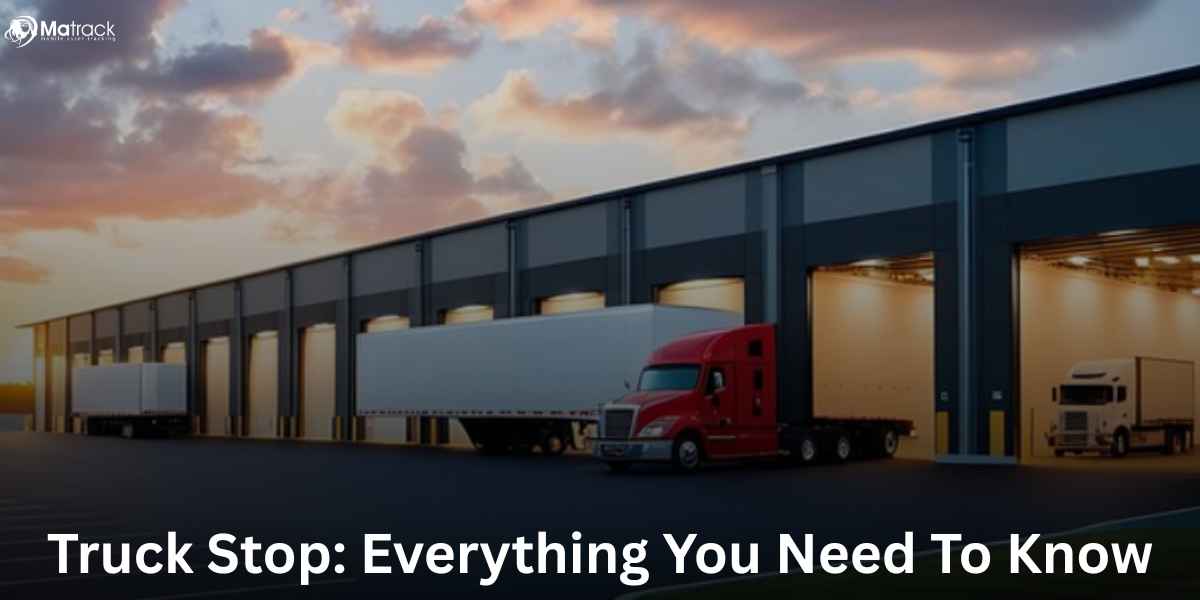Key Takeaways:
- A truck stop is a highway facility that provides fuel, food, parking, repairs, and rest for long-haul drivers.
- Modern truck stops include essential features like fueling bays, showers, maintenance shops, and secure overnight parking.
- Truck stops improve freight movement by supporting legal rest breaks, quick repairs, and time-saving services.
- Matrack helps at truck stops with GPS tracking, ELD compliance, and dash cams for efficient and safe operations.
What is a Truck Stop?
A truck stop is a highway-side service center built for truck drivers who cover long distances. It offers fuel, food, restrooms, parking, and basic repairs in one stop.
Truck drivers use these places to rest, refuel, and stay within driving limits set by law. This keeps deliveries on schedule and helps freight move without delays.
What are the Features of a Modern Truck Stop?
Modern truck stops are designed to meet every core need of long-haul drivers. Each feature supports rest, repair, and route efficiency.
Fueling Bays
Diesel pumps at truck stops handle high-volume refueling for commercial trucks. Many locations include DEF dispensers and weigh stations to speed up compliance checks.
Parking Spaces
Most sites offer between 50 to 200 overnight parking spots. Reserved slots through mobile apps reduce wait times and parking stress.
Showers and Restrooms
Private showers and clean restrooms help drivers manage hygiene during multi-day hauls. Some stops also include laundry services for added convenience.
Restaurants
On-site food ranges from fast chains to 24-hour diners and buffets. Balanced meals improve driver focus and health during long trips.
Vehicle Maintenance Shops
Repair bays handle oil changes, tire work, and minor mechanical issues. Quick servicing keeps trucks roadworthy without leaving the route.
Convenience Stores
Drivers can restock drinks, snacks, and supplies like chargers and logbooks. These stores prevent extra stops and save travel time.
Lodging Facilities
Attached motels and sleeper pods give drivers a real bed when cab sleep isn’t enough. This improves rest quality between long shifts.
Entertainment Lounges
TV rooms, fitness areas, and internet lounges help drivers relax. Mental breaks between shifts improve mood and alertness.
What are the Types of Truck Stops?
Full-Service Truck Stops
Full-service truck stops provide fuel, food, parking, repairs, showers, and lodging in one location. They are built for long-haul drivers who need all services without leaving the route.
Independent Truck Stops
Independent truck stops operate as standalone sites serving specific regional corridors. They offer basic services and are often tailored to local traffic patterns.
Chain Truck Stops
Chain truck stops operate across multiple states with uniform services and layouts. Drivers use them for predictable access to fuel, food, and rest across long distances.
Urban Truck Stops
Urban truck stops are located near city limits and support short-haul or last-mile deliveries. They offer limited parking and services due to space restrictions.
Dedicated Fleet Stops
Dedicated fleet stops are owned and managed by trucking companies for their own drivers. These stops cut operating costs and improve service coordination for the fleet.
Why is a Truck Stop Important in the Freight Movement?
Mandated Rest
Truck stops help drivers meet Hours-of-Service rules. They provide safe places to sleep in cabs or nearby motels.
Vehicle Maintenance
Vehicle maintenance is important during long-distance driving. Many truck stops offer tire services, diesel bays, and basic mechanical support.
Food and Hygiene
Long hauls drain energy fast. Meals, showers, and clean restrooms found at truck stops help drivers stay sharp.
Time Efficiency
Drivers lose time searching for separate services. A full-service truck stop keeps everything in one place and on route.
What is the History of Truck Stops in the U.S.?
Truck stops developed in six phases. Each phase aligned with shifts in transportation, regulation, and logistics strategy.
- Pre-1950s Fuel Stations: Before interstates, fuel pumps attached to diners and garages were the only roadside stops for truckers.
- Interstate Expansion Era (1956–1970): Eisenhower’s Highway Act created I-10, I-40, and I-80 routes, leading to specialized truck facilities.
- Regulatory Rise (1970s): With HOS regulations introduced, truck stops expanded parking lots and built showers and lounges.
- Brand Consolidation (1980–2000): Chains like TA, Love’s, and Flying J emerged, offering reward systems and consistent amenities.
- Digital Transformation (2000–2015): Mobile apps enabled real-time fuel pricing, parking reservations, and navigation.
- Sustainability Shift (2015–Present): Electric charging, DEF fueling, and green buildings emerged in response to environmental regulation.
What is the Future of Truck Stops?
Electric Charging Infrastructure
EV charging hubs will support electric semis and delivery trucks at scale. These hubs will reduce idle time and match future vehicle needs.
Modular Sleeping Pods
AI-controlled sleep pods will manage light, temperature, and noise. Drivers will get higher quality rest without needing motel rooms.
Contactless Automation
App-based systems will handle fueling, payments, and food ordering. This cuts service time and limits face-to-face delays.
Green Logistics Design
Truck stops will add solar panels, waste recycling, and water-saving systems. These upgrades reduce environmental impact and cut operational costs.
Fleet-Specific Services
Stops will connect directly to fleet tracking systems through APIs and ELD sync. This gives trucking companies more control over routing, fueling, and downtime.
What is the Future of Truck Stops?
Electric Charging Infrastructure
EV charging hubs will support electric semis and delivery trucks at scale. These hubs will reduce idle time and match future vehicle needs.
Modular Sleeping Pods
AI-controlled sleep pods will manage light, temperature, and noise. Drivers will get higher quality rest without needing motel rooms.
Contactless Automation
App-based systems will handle fueling, payments, and food ordering. This cuts service time and limits face-to-face delays.
Green Logistics Design
Truck stops will add solar panels, waste recycling, and water-saving systems. These upgrades reduce environmental impact and cut operational costs.
Fleet-Specific Services
Stops will connect directly to fleet tracking systems through APIs and ELD sync. This gives trucking companies more control over routing, fueling, and downtime.
How Matrack Helps You In Truck Stop?
Matrack improves truck stop planning with its GPS fleet tracking system. It gives managers real-time location data, helping them direct drivers to the nearest or best-equipped stops.
Its ELD solution supports HOS compliance during stopovers. Drivers receive alerts for required breaks, helping them avoid violations.
Matrack’s fleet dash cam enhances safety during stops by recording surroundings and detecting unsafe behavior. It provides visual evidence in case of incidents and supports driver coaching.



